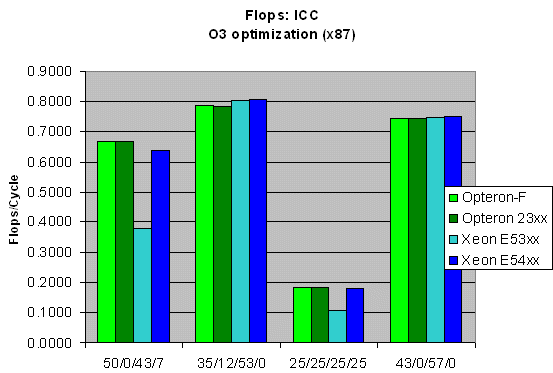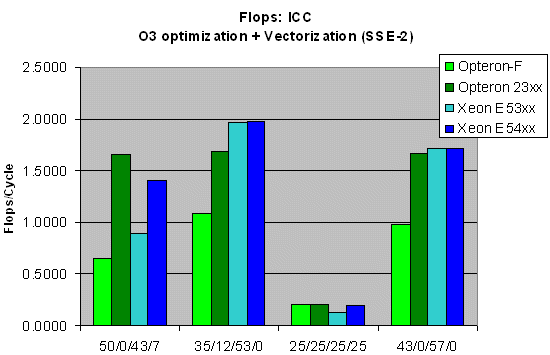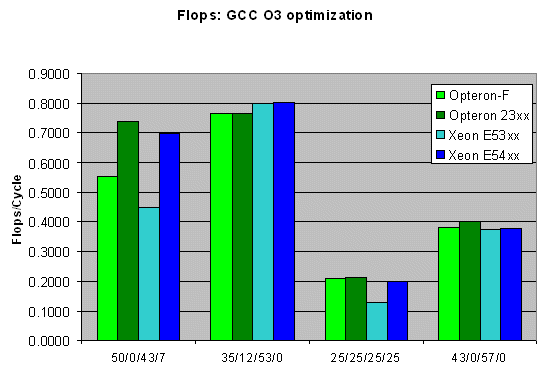AMD's 3rd generation Opteron versus Intel's 45nm Xeon: a closer look
by Johan De Gelas on November 27, 2007 6:00 AM EST- Posted in
- IT Computing
Raw FPU power: FLOPS
Let us see if we understand floating-point performance better when we look at FLOPS. FLOPS was programmed by Al Aburto and is a very floating-point intensive benchmark. Analysis show that this benchmark contains:
- 70% floating-point
instructions
- Only 4% branches
- Only 34% of instructions are memory instructions
Benchmarking with FLOPS is not real world, but isolates the FPU power. Al Aburto states the following about FLOPS:
"Flops.c is a 'C' program which attempts to estimate your systems floating-point 'MFLOPS' rating for the FADD, FSUB, FMUL, and FDIV operations based on specific 'instruction mixes'. The program provides an estimate of PEAK MFLOPS performance by making maximal use of register variables with minimal interaction with main memory. The execution loops are all small so that they will fit in any cache."
FLOPS shows the maximum double precision power that the core has, by making sure that the program fits in the L1 cache. FLOPS consists of eight tests, and each test has a different but well-known instruction mix. The most frequently used instructions are FADD (addition, 1st number), FSUB (subtraction, 2nd number), and FMUL (multiplication, 3rd number). FDIV is the fourth number in the mix. We focused on four tests (1, 3, 4, and 8) as the other tests were very similar.
We compiled three versions:
- Gcc
(GCC) 4.1.2 20070115 (prerelease) (SUSE Linux)
- Intel C Compiler (ICC) version 10.1 20070913:
- An x87 version
- A fully vectorized SSE2 version
- An x87 version
Let us restate what we are measuring with FLOPS:
- Single-threaded
double precision floating performance
- Maximum performance not constrained by bandwidth bottlenecks or latency delays
- Perfect clock speed scaling
This allows us to calculate the FLOPS per cycle number: we divide the MFLOPs numbers reported by FLOPS by the clock speed. This way we get a good idea of the raw floating-point power of each architecture. First we test with the basic '-O3' optimization.

Don't you love the little FLOPS benchmark? It is far from a real world benchmark, but it tells us so much.
To understand this better, know that the raw speed of the AMD out of order x87 FPU (Athlon K7 and Athlon 64) used to be between 20% and 60% faster clock for clock than any P6 based CPU, including Banias and Dothan. However, this x87 FPU advantage has evaporated since the introduction of the Core architecture as the Core Architecture has a separate FMUL and FADD pipe. (Older P6 architectures could execute one FADD followed by one FMUL, or two FP operations per two clocks at the most). You can see that when we test with a mix of FADD/FSUB and FMUL, the Core architecture is slightly faster clock for clock.
The only weakness remaining in the Core x87 architecture is the FP divider. Notice how even a relatively low percentage of divisions (the 4th number in the mix) kills the performance of our 65nm Xeon. The Opteron 22xx and 23xx are 70% faster (sometimes more) when it comes to double precision FP divisions. However, the new Xeon 54xx closes this gap completely thanks to lowering the latency of a 64-bit FDIV from 32 cycles (Xeon 53xx) to 20 cycles (Xeon 54xx, Opteron 23xx). The Xeon 54xx is only 1% to 5% slower in the scenarios where quite a few divisions happen. That is because the Opterons are capable of somewhat pipelining FDIVs, which allows them to retire one FDIV every 17 cycles. The clock speed advantage of the 45nm Xeon (3.2GHz vs. 2.5GHz maximum at present) will give it a solid lead in x87 performance.
However, x87 performance is not as important as it used to be. Most modern FP applications make good use of the SSE SIMD instruction set. Let us see what happens if we "vectorize" our small FLOPS loops. Remember, FLOPS runs from the L1 cache, so L2 and memory bandwidth do not matter at all.

When it comes to raw SSE performance, the Intel architectures are 3% to 14% faster in the add/subtract/multiply scenarios. When there are divisions involved, Barcelona absolutely annihilates the 65nm Core architecture with up to 80% better SSE performance, clock for clock. It even manages to outperform the newest 45nm Xeon, but only by 8% to 18%. Notice once again the vast improvement from the 2nd generation Opteron to the 3rd generation Opteron when it comes to SIMD performance, ranging from 55% to 150% (!!).
As not all applications are compiled using Intel's high-performance compiler, we also compiled with the popular open source compiler gcc. Optimization beyond "-O3" had little effect on our FLOPS binary, so we limited our testing to one binary.

GCC paints about the same picture as ICC without vectorization. The new AMD Barcelona core has a small advantage, as it is the fastest chip in 3 out of 4 tests. Let us now see if we can apply our FP analyses of LINPACK and FLOPS to real world applications.










43 Comments
View All Comments
befair - Friday, November 28, 2008 - link
ok .. getting tired of this! Intel loving Anandtech employs very unfair & unreasonable tactics to show AMD processors in bad light every single time. And most readers have no clue about the jargon Anandtech uses every time.1 - HPL needs to be compiled with appropriate flags to optimize code for the processor. Anandtech always uses the code that is optimized for Intel processors to measure performance on AMD processors. As much as AMD and Intel are binary compatible, when measuring performance even a college grad who studies HPC knows the code has to be recompiled with the appropriate flags
2 - Clever words: sometimes even 4 GFLOPS is described as significant performance difference
3- "The Math Kernel Libraries are so well optimized that the effect of memory speed is minimized." - So ... MKL use is justified because Intel processors need optimized libraries for good performance. However, they dont want to use ACML for AMD processors. Instead they want to use MKL optimized for Intel on AMD processors. Whats more ... Intel codes optimize only for Intel processors and disable everything for every other processors. They have corrected it now but who knows!! read here http://techreport.com/discussions.x/8547">http://techreport.com/discussions.x/8547
I am not saying anything bad about either processor but an independent site that claims to be fair and objective in bringing facts to the readers is anything but fair and just!!! what a load!
DonPMitchell - Friday, December 7, 2007 - link
I think a lot of us are intrigued by AMD's memory architecture, its ability to support NUMA, etc. A lot of benchmarch test how fast a small application runs with a high cash-hit rate, and that's not necessarily interesting to everyone.The MySQL test is the right direction, but I'd rather see numbers for a more sophisticated application that utilizes multiple cores -- Oracle or MS SQL Server, for example. These are products designed to run on big iron like Unisys multi-proc servers, so what happens when they are running on these more economical Harpertown or Barcelona.
kalyanakrishna - Thursday, November 29, 2007 - link
http://scalability.org/?p=453">http://scalability.org/?p=453kalyanakrishna - Thursday, November 29, 2007 - link
a much better review than the original one. But I still see some cleverly put sentences, wish it were otherwise.Viditor - Thursday, November 29, 2007 - link
Nice review Johan!On the steppimgs note you made, it's not the B2 stepping that is supposed to perform better, it's the BA stepping...
The BA stepping was the improved form for B1s, and the B3 stepping is the improved form of the B2. BA and B2 came out at the same time in Sept (though BA was the one launched, B1 was what was reviewed), B2 for Phenom and performance clockspeeds, BA for standard and low power chips.
Do you happen to have a BA chip to test (those are the production chips)?
BitByBit - Wednesday, November 28, 2007 - link
Despite K10's rather extensive architectural improvements, it looks likes its core performance isn't too different to K8. In fact, the gains we've seen so far could easily be attributable to the improved memory controller and increased cache bandwidth. It seems that introducing load reordering, a dedicated stack, improved branch prediction, 32B instruction fetch, and improved prefetching has had little impact, certainly far less than expected. The question is, why?JohanAnandtech - Wednesday, November 28, 2007 - link
Well, we are still seeing 5-10% better integer performance on applications that are runing in the L2, so it is more than just a K8 with a better IMC. But you are right, I expected more too.However, the MySQL benchmark deserves more attention. In this case the Barcelona core is considerably faster than the previous generation (+ 25%). This might be a case where 32 bit fetch and load reordering are helping big time. But unfortunately our Codeanalyst failed to give all the numbers we needed
BaronMatrix - Wednesday, November 28, 2007 - link
At any rate, it was the most in-depth review I've seen, especially with the code analysis. I too, thought it would be higher, but remember that Barcelona is NOT HT3 and doesn't have the advantage of "gangning\unganging." There was an interesting article recently that showed perf CAN be improved by unganging (maybe it was ganging, can't find it) the HT3 links.I really hate that OEMs decided to stand up to the big, bad AMD and DEMAND that Barcelona NOT have HT3 with ALL OF ITS BENEFITS.
I mean people complain that Barcelona uses more power, but HT3 would cut that somewhat. At least in idle mode, and even in cases where IMC is used more than the CPU or vice versa.
I also may as well use this to CONDEMN all of these "analysts" who insist on crapping on the underdog that keeps prices reasonable and technology advancing.
INSERT SEVERAL EXPLETIVES. REPEATEDLY. FOR A FEW DAYS. A WEEK. FOR A YEAR.
INSERT MORE EXPLETIVES.
donaldrumsfeld - Wednesday, November 28, 2007 - link
Conjecture regarding why AMD went quad core on the same die... and this has nothing to do with performance. I think one place where Intel is way ahead of AMD is package technology. Remember they were doing a type of Multichip module with the P6. Having 2 dice instead of a single die allows them to have an overall lower defect rate, higher yield, and higher GHz. This is vs. AMD's lower GHz but (it was hoped) greater data efficiency using an L3 die and lower latency of on-die communications amongst cores vs. Intel's solution of die to die communication.Can anyone confirm/deny this?
thanks
tshen83 - Tuesday, November 27, 2007 - link
Seriously, can you buy the 2360SE? Newegg doesn't even stock the 1.7Ghz 2344HEs.The same situation exist on the Phenom line of CPUs. I don't see the value of reviewing Phenom 9700, 9900s when AMD cannot deliver them. I have trouble locating Phenom 9500s.